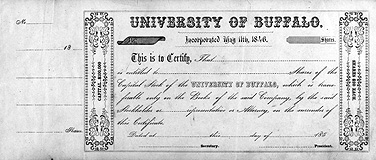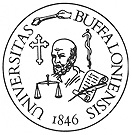Flashback
165 years ago
Charter Day

A blank stock certificate from the 1850s. Photo: UB ARCHIVES
-
 Print
Print -
 Comments
(1)
Comments
(1)
-

Original seal of the University of Buffalo. Photo: COURTESY UB ARCHIVES
UB was granted a charter by the New York State Legislature on May 11, 1846. Earlier that year, a petition of “sundry inhabitants of county of Erie prayed for the incorporation of the University of Buffalo.” After the petition was read in the Assembly’s Committee on Colleges, Academies and Common Schools, a bill entitled “An act to incorporate the University of Buffalo” was sent forward for consideration by the entire legislature.
When the bill was approved on May 11, it “constituted a body corporate by the name of the University of Buffalo, for the purpose of promoting literature and science by establishing and maintaining a university in the city of Buffalo.”
The act called for issuing a maximum of $100,000 in capital stock in shares of $20 each and required the petitioners to open a book for subscriptions within 30 days. Upon issuing $20,000 in stock, the holders of stock were to form a governing council for the new university.
On May 29, 1846, 13 prominent citizens met in the law office of Nathan K. Hall and selected G. Barrett. Rich to serve as chairman of the stock subscription effort. The book for stock subscriptions was to be opened in Rich's office on June 5.
UB’s charter did not establish a medical school. It incorporated a university with the authority to “grant degrees and diplomas as are usually granted by any university college seminary.” Incorporating symbols for law, theology and the liberal arts, with Hippocrates and the caduceus representing medicine, the original seal of the university reflected the vision of the founders.
The charter established a non-sectarian university (“persons of every religious denomination shall be equally eligible to all offices and appointments”) and, by implication, permitted the admission of women. It also was stipulated that the university bear the name of the city, not of an individual.
In remarks made at the celebration of the 25th anniversary of the College of Arts and Sciences on May 14, 1938, Chancellor Samuel P. Capen described the origins of the university and how UB was one of only a handful of American universities that had not grown out of colleges of liberal arts.
“The University of Buffalo,” Capen said, “has evolved from a medical school; but from a medical school with a peculiar vision. The distinguished physicians and laymen who were the prime movers in the establishment of this institution, while eager to provide medical service for the rapidly growing population of Western New York, saw from the first the larger educational needs of the community.
“They obtained from the legislature a charter not for a medical school but for a university,” Capen continued. He noted that for its first 40 years, UB had only a medical program before adding, in quick succession, schools of pharmacy, law, dentistry and a short-lived school of pedagogy.
As we celebrate the 165th anniversary of the university, we also should remember that, according to Capen, UB did not become a university until the founding of the College of Arts and Sciences—“this central indispensable unit”—the centennial of which is fast approaching.
Included among the holdings of the University Archives on the founding and early years of the university is the original 1846 subscription stock book that includes the signatures of the initial 28 subscribers and an indication of the number of shares purchased. No dividends were ever paid. All of the stock had been signed back to the university by 1909.
Millard Fillmore, who would become the university’s first chancellor, purchased only a single share.
—John Edens, University Archives

Reader Comments
Shonnie Finnegan says:
These Flashback articles by John Edens have been so carefully researched, well written, and fascinating to read. I think it's a great shame that they will most likely cease with John's forthcoming retirement-- and with no apparent plans to find a successor university archivist/ university historian any time soon.
Posted by Shonnie Finnegan, University Archivist Emerita, 05/05/11